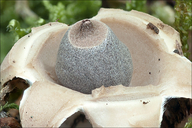|
|
click photo for larger file

Geastrum quadrifidum
Rayed Earthstar
|
Photographer: Dr. Amadej Trnkoczy
ID: 0000 0000 0914 2672 (2014-09-29)Copyright © 2014 Dr. Amadej Trnkoczy
|
|
INFORMATION PROVIDED WITH THE PHOTO
|
date of photo Sep 9, 2014
latitude 46.36529 longitude 13.74988
View on Google Maps.
location
Lower Trenta valley, near the trail from Trenta village to Zasavska koča na Prehodavcih mountain cottage, halfway between the village and Planina Lepoč, East Julian Alps (Posočje, Slovenia)notes Slo.: četverokraka zvezdica - Geastrum coronatum Scopoli - Habitat: mixed wood, Picea abies and Fagus sylvatica dominant, moderately steep, southeast oriented mountain slope, calcareous skeletal ground covered by leaf and needles litter without ground vegetation, under Picea abies, in shade, partly protected from direct rain by tree canopies, average precipitations ~ 3.000 mm/year, average temperature 5-7 deg C, elevation 950 m (3.100 feet), alpine phytogeographical region. - Substratum: on moss covering a small Picea abies stump in the last disintegration stage, decomposed to almost soil. - Comments: Genus Geastrum contains very attractive fungi, which almost all are rather uncommon, if not rare. Globose or onion shaped fruit bodies of many start to develop underground. The 'shell' of their fruit bodies consists of four distinct layers (with some exceptions). The outer three form so called exoperidium and the inner one is endoperidium, a 'sack', which contains spores. Exoperidium's outer layer consists of mycelium, the middle layer consists of fibers and the inner one is so called pseudoparenchymal layer. During growth the last one swells and breaks the exoperidium into star like shaped lappets, which curl backward and in this way push the fruit body out of the ground. In some species, like with Geastrum quadrifidum, the outer mycelial layer does not split together with other two layers of the exoperidium but falls off and forms a kind of 'bird's nest' in ground on top of which the fruit body sits. This white mycelial 'nest' can be seen on Fig. 3. The fruit body, when mature, cuts itself almost completely off the mycelium and stands free, like on legs made of exoperidium flaps. Only the far ends of the laps stay in connection with the 'nest'. In this way endoperidium with its 'chimney' (peristom) on top, through which clouds of spores rise like a 'smoke', is positioned as high as possible to facilitate spore spreading by the wind. - Geastrum quadrifidum is among the smallest species of about 50 of them worldwide (and ten of them described in Slovenian checklist (Ref.7)). It is a rare find. As its species name suggests it usually has four exoperidium 'legs'. However, sometimes, as in my find, it has five of them. - Growing solitary; exoperidium diameter 20 mm, endoperidium diameter 8 mm, its height (without the peristom 'beak') 7 mm; SP and spores on mass dark brown; smell none; taste not tested (too small). Spores coarsely warty. Dimensions excluding warts: 4.4 [5 ; 5.2] 5.7 x 4.1 [4.5 ; 4.7] 5.2 microns; Q = 1 [1.1] 1.2; N = 40; C = 95%; Me = 5.1 x 4.6 microns; Qe = 1.1; number of warts per circumference: AVG = 12.1, SD = 1.2, N = 30. Olympus CH20, NEA 100x/1.25, magnification 1.000 x, oil; AmScope MA500 digital camera. - Herbarium: Mycotheca and lichen herbarium (LJU-Li) of Slovenian Forestry Institute, Večna pot 2, Ljubljana, Index Herbariorum LJF - Ref.: (1) G.J. Krieglsteiner (Hrsg.), Die Grosspilze Baden-Württembergs, Band 2., Ulmer (2000), p 116. (2) S. Buczacki, Collins Fungi Guide, Collins (2012), p 440. (3) W. Rothmaler, Exkursionsflora von Deutschland, Vol.1, Niedere Pflanzen, Elsevier, 3.Auflage, (1994), p 519. (4) M. Bon, Parey's Buch der Pilze, Kosmos (2005), p 302.(5) J. Breitenbach, F. Kraenzlin, Eds., Fungi of Switzerland, Vol.2. Verlag Mykologia(1986), p 382.(6) R. Phillips, Mushrooms, Macmillan (2006), p 334. (7) A. Poler, ed., Seznam gliv Slovenije (in Slovene), 2nd Ed., Assoc. of Mycol. Soc. of Slovenia (1998), p 29.camera Nikon D700/Nikkor Micro 105mm/f2.8
contributor's ID # Bot_835/2014_DSC3951 photo category: Fungi - fungi
|
MORE INFORMATION ABOUT THIS FUNGUS
|
| common names
Rayed Earthstar (photographer)
View all photos in CalPhotos of Geastrum quadrifidum Check Google Images for Geastrum quadrifidum |
|
The photographer's identification Geastrum quadrifidum has not been reviewed. Click here to review or comment on the identification. |
|
Using this photo The thumbnail photo (128x192 pixels) on this page may be freely used for personal or academic purposes without prior permission under the Fair Use provisions of US copyright law as long as the photo is clearly credited with © 2014 Dr. Amadej Trnkoczy.
For other uses, or if you have questions, contact Dr. Amadej Trnkoczy amadej.trnkoczy[AT]siol.net. (Replace the [AT] with the @ symbol before sending an email.) |
|
|
